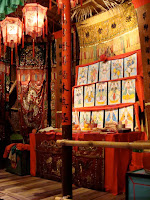
This will be a quick photo post, with details to follow.
In the natural history section, they created dioramas of the main ecosystems in Hong Kong, like forest,

mangrove,

dry, rocky shoreline,

bamboo.

I think I enjoyed the ethnography section the most. Different groups living in Hong Kong could lead very different lives. For example, the Boat Dwellers lived their lives almost entirely on the water, going on land only when necessary to transact business. They would live on their fishing boats, much like this one.

Dried fish was an important source of food and income for the Boat Dwellers.

I believe this is from the Hakka tradition. There was no description of the grid on the kitchen table. Would anyone have an idea of what it could be?

These lamps are from the Hoklo tradition.

The following photos are from a recreation of the Taiping Qingjiao ceremony held annually in Cheung Chau. It is a festival of thanksgiving for deliverance from plague and pirates that were devastating the village in the 18th century.

Detail from a temporary paper shrine

Papier maché representations of protective village deities.

Chinese opera.

Bun mountains, with parade dragons in the foreground. The original bun mountains were built on bamboo frames. Young men would climb them and compete to see who could snatch the highest bun. The higher the bun, the greater the good fortune it was supposed to bring.


Taoist altar.

In another section of the museum describing the Opium Wars (1839 to 1942, and 1856 to 1860), I found this statue that I liked. Sorry I don't have more information on it.


No comments:
Post a Comment